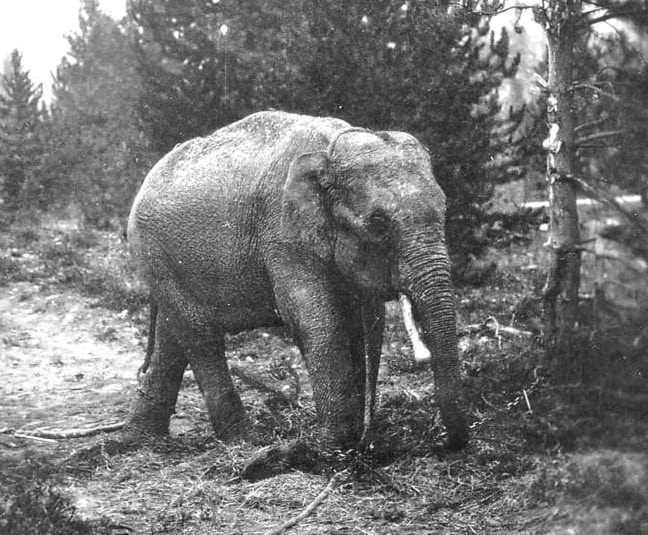It was a hazy day in the middle of September 1926. Forest fires blazed in region, leaving a haze over the East Kootenay's valleys. Still, the air was crisp. The first snowfall of the season was only a day away.
In the forest near Moyie Lake, five faces were barely visible amongst the brush. They watched silently barely moving, as a small grey elephants moved past them in the clearing.
Suddenly, there's a crack and roar. The elephant pulls, but he can't move forward. Little Charlie Ed is caught in a snare set by aboriginal trackers and circus handlers.
"Charlie Ed was jerked back: the cord about his neck tightened as he plunged and threshed about. Time and again he was thrown back on his haunches by the spring of the trees. The hard cord noose bit deeper into his neck, choking him down. Poor little Charlie Ed! His relentless pursuers had beaten him at last," wrote the Cranbrook Courier on September 16, 1926.
Finally, the elephant was back in captivity, sore but none the worse for wear for his adventure. The great saga of Cranbrook's 1926 elephant stampede had come to an end.
These days, the story of how Cranbrook came to claim a small circus elephant as its own has steeped into the mists of legend. Most of us know a little about the tale, but not all. Some aren't too sure why there is a bronze elephant statue in the heart of Cranbrook's downtown.
It's a tale that deserves retelling, for even those who know the story may not be aware of what happened to Cranbrook's famed elephants after they returned to the circus.
The trouble started on August 2, 1926, in Edmonton. Founded in 1902 as the Otto Floto Dog and Pony Show, by 1926 the Sells-Floto Circus was a massive production, travelling across Canada and the U.S. by rail.
There were 14 elephants in the menagerie. But that fateful day in Edmonton, according to a Gordon Brown article in Bandstand, the Circus Historical Society's newsletter, a small, yapping dog set the elephants off. One of the bulls, Mary, startled and ran from the railroad yards. The rest of the elephants quickly followed. They ran through Edmonton's streets, destroying gardens, tearing verandahs from houses, and startling many a resident.
By nightfall, all except Mary has been recaptured. Terrified, she retreated to the brush. Handlers brought out Trilby, the menagerie's lead elephant. At the sight of Trilby, Mary shrieked like a scared child and ran to her. Trilby wrapped her trunk around the smaller elephant, and they stood rumbling to each other as handlers secured the pair.
Four days later, on Friday, August 6, 1926, the Sells-Floto Circus had made its way to Cranbrook. On that well-remembered day, as the elephants were being led off the train, something startled them. Some reports are that a steam whistle set them off.
This time, six elephants ran. According to the Courier's Aug. 12 issue, one local man got a fright when a passing elephant swept him off his horse. A circus worker suffered minor injuries in the rush.
Three head directly for the cemetery, where they grazed until circus handlers arrived and calmly took them back to the railyard.
But three elephants remained at large: Tillie, Myrtle and Charlie Ed. Tillie headed north into Wycliffe. Myrtle and Charlie Ed stuck together and barrelled toward Gold Creek.
Meanwhile, Canadian Pacific dispatcher Frank Guimont hurriedly sent out a strange telegraph down the railway line.
"To all trains east – keep lookout for elephants on track. Advise if sighted from the first telegraph office giving location."
Cranbrook instantly became a household name all over the continent. The two local newspapers, the Herald and the Courier, received requests for articles about the stampede from Toronto, Seattle, Los Angeles, San Francisco and Portland. Local reporters penned some 30,000 words in the coming weeks, with the story reaching as far as Cuba.
Tune in tomorrow when we learn how the elephants fared in the wilds of the East Kootenay.
